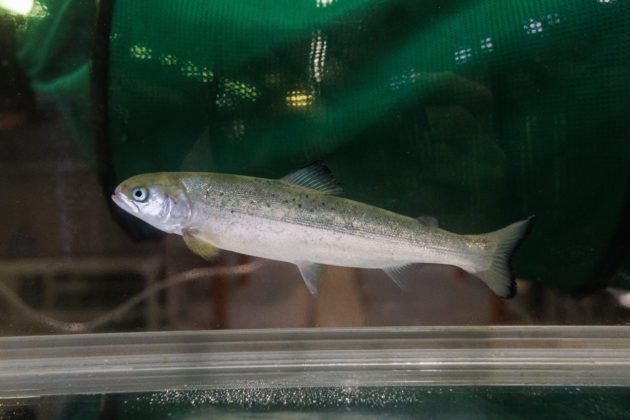
by Georg Mathisen, Nofima
Perhaps it is best for the health of farmed salmon if they do not grow as quickly during the initial period. But this is difficult for researchers to ascertain, because Norwegian fish farmers use several different methods for farming the salmon.
“There is no shared basic knowledge,” as Trine Ytrestøyl puts it. The senior scientist at Nofima is working to collect knowledge of how salmon can grow well and live long enough after being released into salt water.
“Things are done differently at each facility according to the lessons they’ve learnt,” she says.
Large enough for salt water
Now she is heading up a project to find out more. It is completely focused on smolt – i.e., the juvenile fish that are ready to make the transition from freshwater to salt water. When should they be released into the sea, and how big should they be? In Norway, the answer differs from facility to facility and from region to region, according to the survey conducted by Ytrestøyl and her colleagues.
In the wild, salmon weigh 30 to 50 grams when they migrate downstream into the sea. Farmed salmon are larger. In Norway, the average weight of those released in the spring is 200 grams, but 180 grams for those released in autumn.
“The time of year when the big smolt are released varies. Roughly half are released in summer, while 27 per cent of the fish are released in January and February. This seems to indicate that it may not be ideal for them,” she says.
Growing too rapidly
Ytrestøyl compares this to the aquaculture industry in the Faroe Islands which has more extensive experience of releasing large smolt. The data indicate that the size of the smolt upon release does not have a significant impact on how well it survives or how much it grows in the sea. The crucial factors seem to be whether the smolt lived in warmer freshwater as juveniles and thus grew more rapidly before being released into the sea.
“Fish that have grown rapidly during the land phase grew less and had poorer survival rates in the sea,” she says.
An overview of a similar nature doesn’t exist in Norway. In order to obtain this type of data, researchers must collect data from each individual fish farming company. This can be difficult to obtain due to competition considerations. Relatively few fish farmers produce large smolt in Norway, so this data might be sensitive.
Must be larger
Even so, the fish farmers want larger smolt. Roughly 20 per cent of fish farmers in Norway release salmon that are larger than 250 grams. More than one in three of those who are not currently doing this are considering whether to produce smolt of this same size. Of those already in the process, two out of three are considering whether to increase the proportion of big smolt.
Salmon that spend more time in freshwater and less in the sea may have fewer problems with salmon lice. In order words, better growth, better fish welfare and lower mortality. In addition, this enables fish farmers to exploit their licences better.
On the other hand, large smolt can have other health problems. The fish farmers report on fish with more gill problems, wider size deviation, poorer appetite and higher mortality rate after being released into the sea.
Different winter signals
In the Faroe Islands, the average size of the smolt released into the sea is now more than 400 grams. But this Faroese data cannot simply be transferred to Norwegian conditions.
“In the Faroe Islands, they use a different production method during the freshwater phase,” Trine Ytrestøyl explains. In the islands, the salmon receive slightly different signals that tell them when it’s time to prepare for salt water. They experience a period of short days making the fish think that winter has arrived. In Norway, this winter signal is shorter. Faroe island salmon are also kept in freshwater until release, whereas the use of brackish water is common in Norway.
Finding knowledge gaps
Part of Ytrestøyl’s research project has been to identify where knowledge is lacking. “We’ve seen a dearth of literature on large smolt, as well as the fact that fish farmers are reportedly uncertain about how to carry out this process. They try out different things,” she said.
Seeing that production is done in such a wide variety of ways also makes it difficult to pinpoint the factors affecting salmon survival after being released into the sea.
“In order to draw any conclusions about an optimal solution, we need more data from those fish farmers who are doing things differently. This shows how crucial it is to collaborate with major operators,” Trine Ytrestøyl says.
More knowledge available
Fish farmers interested in obtaining more specific knowledge about the researchers’ recommendations are encouraged to read the report, found below.
As part of the project, Åkerblå and BDO are setting up an e-learning course that will be available at https://akvademiet.no/ from 16 June.
Contact person
Trine Ytrestøyl
Senior Scientist
+47 71 40 01 35
trine.ytrestoyl@nofima.no
Publication (open access)
Rosendal, K., Kettunen, A. and Olesen, I. (2023), Policies to promote breeding for lice-resistant salmon – incentives designed for resilient and sustainable growth in aquaculture?. J Fish Biol. Accepted Author Manuscript. https://doi.org/10.1111/jfb.15470

